Traditionalist Issues
 |
 |
 |
 |
 |
 |
 |
Dialogue Mass - V
Laity-Clergy Class Struggle
Based on ‘Active Participation’
If anyone should wonder how the priesthood came to be devalued in the Church and how priests were knocked off the exalted pedestal accorded to them by Catholic Tradition, he need look no further than the beginning of the Liturgical Movement.
Beauduin’s perfidy
At the 1909 Malines Congress, Dom Lambert Beauduin, OSB, delivered an address that purported to be based on Pope Pius X’s recent motu proprio Tra le Sollecitudini on sacred music. But it was only a ruse de guerre (a ruse of war) in his campaign to deceive the faithful and to make it appear as if his intended “liturgical renewal” emanated from that source.
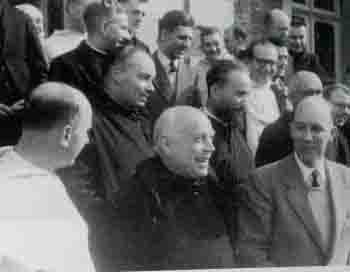 Although he did not, at this early stage, suggest a reform of the liturgical rites, (1) he deftly prepared the groundwork for it by creating, as we shall see below, a deeply hostile climate within which the traditional rites – and even the priesthood itself – would be considered unacceptable.
Although he did not, at this early stage, suggest a reform of the liturgical rites, (1) he deftly prepared the groundwork for it by creating, as we shall see below, a deeply hostile climate within which the traditional rites – and even the priesthood itself – would be considered unacceptable.
Beauduin used his status as a priest with a “pastoral” vision to gain both credibility and active support from Bishops and priests throughout Europe and America. (2) The suspension of disbelief necessary for them to swallow his scheme of “renewal” is impressive.
Therein lies the evidence that the Liturgical Movement originated from an act of perfidy – a word derived from the Latin phrase per fidem decipere, meaning “to deceive through confidence or trust.” It is an apt expression in Beauduin’s case because it is his false pretence that constitutes the perfidy.
An atmosphere of class struggle
What kind of propaganda did Beauduin use to ensure the success of the Liturgical Movement? Utilizing the theme of “active participation,” he contested the right of the priest to say the prayers of the Mass without the congregation joining in.
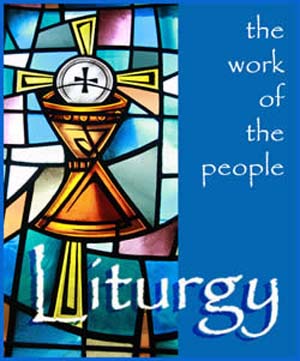 The clergy, according to Beauduin, exercised a despotic rule over the faithful, robbing them of their “active participation” in the liturgy and reducing them to a cowed silence in the pews. This was the underlying message of his 1909 address at the Malines Congress, from which it was inferred (and still is today) that an “aristocratic elite” of clergy excluded the laity from the liturgy and had been violating their rights for centuries.
The clergy, according to Beauduin, exercised a despotic rule over the faithful, robbing them of their “active participation” in the liturgy and reducing them to a cowed silence in the pews. This was the underlying message of his 1909 address at the Malines Congress, from which it was inferred (and still is today) that an “aristocratic elite” of clergy excluded the laity from the liturgy and had been violating their rights for centuries.
“What a shame the liturgy remains the endowment of an elite,” he accused. “We are aristocrats of the liturgy. Everyone should be able to nourish himself from it, even the simplest people. We must democratize the liturgy.” (3)
It is a matter of historical record that Beauduin, like many priests of his time, had been involved in trade unionism and class-oriented politics, (4) and that his radicalized past was heavily implicated in his vision of the liturgy. We are assured this was so by Keith Pecklers, one of Beauduin’s principal biographers, who stated: “His background as a labor chaplain had a tremendous influence upon his liturgical interest.” (5)
Beauduin naturally presented his theories in the form of a binary opposition between priests and laity, as a result of which there could be two – and only two – possible outcomes: the total domination of one side by the other. The polarized context of this message apes the standard Marxist outlook by implying that “ownership” of the liturgy was “in the hands of the few” and that the “oppressed masses” should take back what rightfully belongs to them by virtue of their Baptism.
This rhetoric is clearly in conflict with the reality of Catholic worship through which the Church has always imparted the life of Christ to her members, “even the simplest people,” without the need to “democratize the liturgy.” The very bloodstream of the Church has been poisoned by this language of protest that turned the laity into a symbol of injustices perpetrated by the clergy.
Unfortunately for the Church, we still see the effects of this pernicious propaganda that encourages a victim mentality and incites the laity to rise up against their priests in the name of “active participation”.
The spirit of egalitarianism
It follows from Beauduin’s call to “democratize the liturgy” that no judgment can be made to distinguish the higher role of the priests from the subsidiary one of the faithful. Or, to put it another way, power must be distributed among all the members of the Church to participate “actively” in the liturgy.
All participation must, therefore, be reduced to the lowest common denominator to avoid being accused of “elitism.” This revolutionary idea was accompanied by the wrong belief that the Church can survive in the modern age only by becoming “democratic” i.e., abolishing her patriarchal and hierarchical character.
It was also the major impetus for the exaggerated importance given to the laity in the Vatican II documents, which enlarged the scope and increased the status of their activities in the Church to the detriment of the priesthood.
Beauduin’s lies
It was Beauduin who first propagated the myth (let’s dare to call it a lie) that the custom of silent participation made the laity become “detached” from the liturgy, causing the Mass to lose its communal character and the laity to lose their “community spirit.” Anyone with a Catholic conception of what the Mass really is – and this comes with proper catechesis – would know that these accusations could not possibly represent the truth.
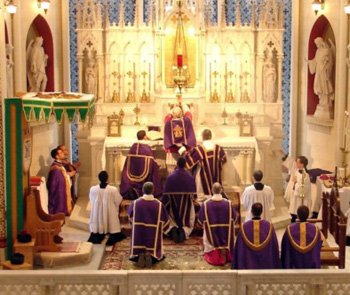 Well instructed Catholics knew the teaching of the Church that the Mass was offered for the glory of God and the benefit of the living and the dead. They knew also that they were united with the Church Triumphant, the Church Militant and the Church Suffering in the Sacrifice of Christ on the altar. In other words, the individual Catholic praying at Mass was already united in the same Faith with the priest whose role was to lead the people towards their heavenly goal.
Well instructed Catholics knew the teaching of the Church that the Mass was offered for the glory of God and the benefit of the living and the dead. They knew also that they were united with the Church Triumphant, the Church Militant and the Church Suffering in the Sacrifice of Christ on the altar. In other words, the individual Catholic praying at Mass was already united in the same Faith with the priest whose role was to lead the people towards their heavenly goal.
Beauduin, however, was not interested in the supernatural dimensions of participation, but in the naturalistic goal of forming communities geared to social action.
Beauduin was also responsible for spreading another lie: The laity, absorbed in their own private prayers, were indulging in individualistic worship, leaving the priest to celebrate without them. He interpreted absence of “active participation” as a sign of “almost complete ignorance or apathy among the faithful in regard to the liturgical worship” (6) and concluded that they understood nothing of the Mass.
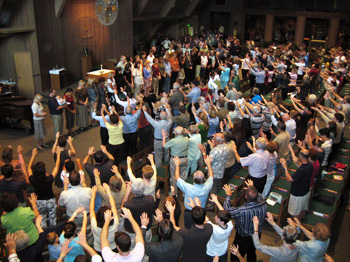 This negative and dismissive assessment inspired Archbishop Bugnini, the architect of the Novus Ordo, to justify his reforms on the basis of a “lack of understanding, ignorance and dark night” (7) in the worship of God since the 6th century.
This negative and dismissive assessment inspired Archbishop Bugnini, the architect of the Novus Ordo, to justify his reforms on the basis of a “lack of understanding, ignorance and dark night” (7) in the worship of God since the 6th century.
So, Beauduin established a series of Liturgical Study Weeks (the first of which was held in 1910) and Retreats at the Monastery of Mont César, specially designed to re-educate parish priests and turn them away from traditional Catholic values. At these sessions, they were indoctrinated to believe that they were guilty of “clericalism” if they celebrated a Mass without a congregation or a Mass at which the faithful did not join in verbally, if they followed the rubrics of the Missal with exactitude or failed to make the liturgy a “living experience” for the congregation.
All these points were set out by Beauduin in the Review, Questions Liturgiques et Paroissiales (Liturgical and Parish Questions) (8) which he had founded in 1909.
Beauduin intended that it was the task of the clergy to indoctrinate their parishioners into going along with the rolling revolution of “active participation,” a process that is still unfolding in our days. His supporters immediately set about the task of persuading the hapless faithful to embrace the new liturgical thinking as their own, believing that it came from Pope Pius X.
It was a propaganda coup of incalculable proportions: its success can be measured today in the proportion of Catholics – clergy and laity – who have come to reject their own tradition on a worldwide scale. The result is that, after devastating a thousand years of received and approved liturgical tradition, nothing remains upon which a true participation could be established.
Continued

Posted May 5, 2014
Beauduin’s perfidy
At the 1909 Malines Congress, Dom Lambert Beauduin, OSB, delivered an address that purported to be based on Pope Pius X’s recent motu proprio Tra le Sollecitudini on sacred music. But it was only a ruse de guerre (a ruse of war) in his campaign to deceive the faithful and to make it appear as if his intended “liturgical renewal” emanated from that source.

Dom Beauduin, center, between Congar, left, and a Protestant pastor at Ecumenical Days in 1952
Beauduin used his status as a priest with a “pastoral” vision to gain both credibility and active support from Bishops and priests throughout Europe and America. (2) The suspension of disbelief necessary for them to swallow his scheme of “renewal” is impressive.
Therein lies the evidence that the Liturgical Movement originated from an act of perfidy – a word derived from the Latin phrase per fidem decipere, meaning “to deceive through confidence or trust.” It is an apt expression in Beauduin’s case because it is his false pretence that constitutes the perfidy.
An atmosphere of class struggle
What kind of propaganda did Beauduin use to ensure the success of the Liturgical Movement? Utilizing the theme of “active participation,” he contested the right of the priest to say the prayers of the Mass without the congregation joining in.

Liturgy became the work of the 'people' - below, a liturgical committee leads Mass responses
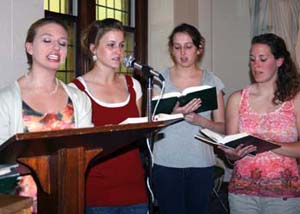
“What a shame the liturgy remains the endowment of an elite,” he accused. “We are aristocrats of the liturgy. Everyone should be able to nourish himself from it, even the simplest people. We must democratize the liturgy.” (3)
It is a matter of historical record that Beauduin, like many priests of his time, had been involved in trade unionism and class-oriented politics, (4) and that his radicalized past was heavily implicated in his vision of the liturgy. We are assured this was so by Keith Pecklers, one of Beauduin’s principal biographers, who stated: “His background as a labor chaplain had a tremendous influence upon his liturgical interest.” (5)
Beauduin naturally presented his theories in the form of a binary opposition between priests and laity, as a result of which there could be two – and only two – possible outcomes: the total domination of one side by the other. The polarized context of this message apes the standard Marxist outlook by implying that “ownership” of the liturgy was “in the hands of the few” and that the “oppressed masses” should take back what rightfully belongs to them by virtue of their Baptism.
This rhetoric is clearly in conflict with the reality of Catholic worship through which the Church has always imparted the life of Christ to her members, “even the simplest people,” without the need to “democratize the liturgy.” The very bloodstream of the Church has been poisoned by this language of protest that turned the laity into a symbol of injustices perpetrated by the clergy.
Unfortunately for the Church, we still see the effects of this pernicious propaganda that encourages a victim mentality and incites the laity to rise up against their priests in the name of “active participation”.
The spirit of egalitarianism
It follows from Beauduin’s call to “democratize the liturgy” that no judgment can be made to distinguish the higher role of the priests from the subsidiary one of the faithful. Or, to put it another way, power must be distributed among all the members of the Church to participate “actively” in the liturgy.
All participation must, therefore, be reduced to the lowest common denominator to avoid being accused of “elitism.” This revolutionary idea was accompanied by the wrong belief that the Church can survive in the modern age only by becoming “democratic” i.e., abolishing her patriarchal and hierarchical character.
It was also the major impetus for the exaggerated importance given to the laity in the Vatican II documents, which enlarged the scope and increased the status of their activities in the Church to the detriment of the priesthood.
Beauduin’s lies
It was Beauduin who first propagated the myth (let’s dare to call it a lie) that the custom of silent participation made the laity become “detached” from the liturgy, causing the Mass to lose its communal character and the laity to lose their “community spirit.” Anyone with a Catholic conception of what the Mass really is – and this comes with proper catechesis – would know that these accusations could not possibly represent the truth.

The Tridentine Mass aimed to give glory to God was called 'elitist' by Beauduin
Beauduin, however, was not interested in the supernatural dimensions of participation, but in the naturalistic goal of forming communities geared to social action.
Beauduin was also responsible for spreading another lie: The laity, absorbed in their own private prayers, were indulging in individualistic worship, leaving the priest to celebrate without them. He interpreted absence of “active participation” as a sign of “almost complete ignorance or apathy among the faithful in regard to the liturgical worship” (6) and concluded that they understood nothing of the Mass.

In the Novus Ordo the whole congregation participates with the priest at the final blessing
So, Beauduin established a series of Liturgical Study Weeks (the first of which was held in 1910) and Retreats at the Monastery of Mont César, specially designed to re-educate parish priests and turn them away from traditional Catholic values. At these sessions, they were indoctrinated to believe that they were guilty of “clericalism” if they celebrated a Mass without a congregation or a Mass at which the faithful did not join in verbally, if they followed the rubrics of the Missal with exactitude or failed to make the liturgy a “living experience” for the congregation.
All these points were set out by Beauduin in the Review, Questions Liturgiques et Paroissiales (Liturgical and Parish Questions) (8) which he had founded in 1909.
Beauduin intended that it was the task of the clergy to indoctrinate their parishioners into going along with the rolling revolution of “active participation,” a process that is still unfolding in our days. His supporters immediately set about the task of persuading the hapless faithful to embrace the new liturgical thinking as their own, believing that it came from Pope Pius X.
It was a propaganda coup of incalculable proportions: its success can be measured today in the proportion of Catholics – clergy and laity – who have come to reject their own tradition on a worldwide scale. The result is that, after devastating a thousand years of received and approved liturgical tradition, nothing remains upon which a true participation could be established.
Continued
- In his Malines Congress address, he criticized as “rubricism” and “formalism” the traditional method of celebrating the Mass, claiming that the liturgy should be turned into a “living experience” for the participants. It was only later, after the Liturgical Movement had put down roots, that it became clearer that Beauduin wanted the liturgical rites to be adapted to the age and circumstances in which they were celebrated.
- In the first instance, he gained the confidence of Card. Mercier to grant permission for the Malines Congress, and persuaded him to use his influence in Rome to approve the Dialogue Mass and experiments in ecumenism. Then, he influenced a visiting Benedictine monk, Dom Virgil Michel, of St John’s Abbey, Minnesota, who translated and published his work and launched the Liturgical Movement in America.
- Apud Sonya Quitslund, A Prophet Vindicated, New York, Newmann Press, 1973, p. 16. Quitslund was a vehement feminist and campaigner for women priests.
- The end of the 19th century was a critical time for social power struggles in Belgium not only between Flemish and Walloon nationalists, but also between workers and employers. With the introduction of universal male suffrage in 1894, some Catholic priests like Beauduin’s mentor, Fr. Antoine Pottier in Liège, involved themselves in mass politics and tried to recruit the support of the newly enfranchised workers in the class struggle.
- Keith Pecklers, The Unread Vision: Liturgical Movement in the United States of America, 1926-1955, Liturgical Press, Collegeville, Minnesota, 1998, p. 9.
- Lambert Beauduin, Liturgy the Life of the Church, trans. Virgil Michel, Collegeville, Minnesota, The Liturgical Press, 1914, p. 8.
- A. Bugnini, La Riforma Liturgica 1948-1975, published in 1983, and in English translation by the Liturgical Press, Collegeville, Minnesota in 1990.
- The Review was initially entitled Questions Liturgiques and was published by the Monastery of Mont César.

Posted May 5, 2014
______________________
______________________
 Volume I |
 Volume II |
 Volume III |
 Volume IV |
 Volume V |
 Volume VI |
 Volume VII |
 Volume VIII |
 Volume IX |
 Volume X |
 Volume XI |
 Special Edition |


